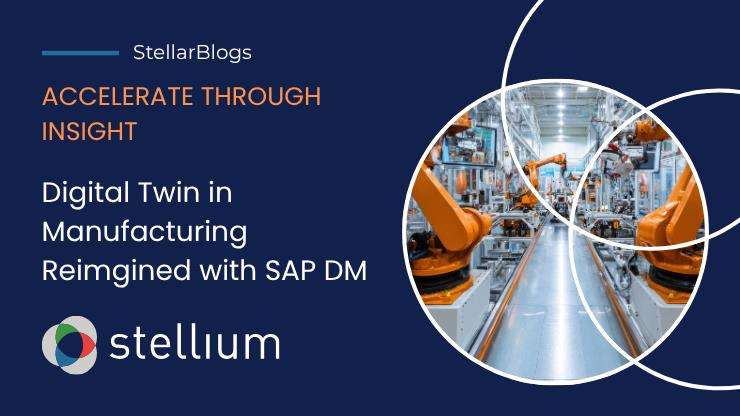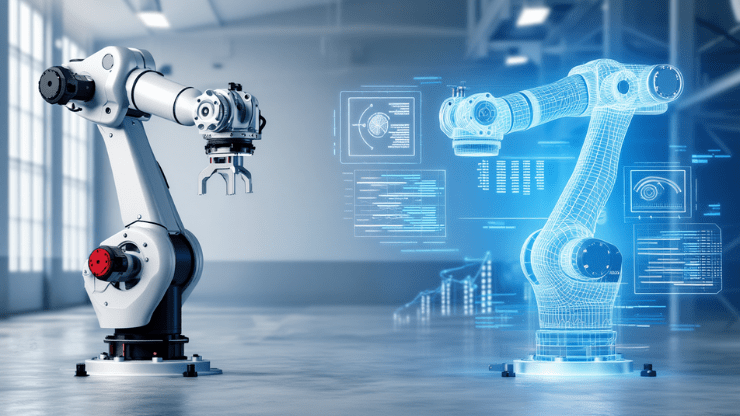
Verified By: Stellium’s Supply Chain Planning & Business Consulting Team, Anirban Majumdar, and Anoop Prasad
Evolving from Physical Production to Predictive Intelligence
Manufacturers today are no longer satisfied with visibility, they need foresight. While the concept of a Digital Twin is not new, its relevance and impact have evolved dramatically with the convergence of SAP Digital Manufacturing (SAP DM), AI, and the SAP Business Technology Platform (BTP).
SAP Digital Manufacturing (SAP DM) version 25.08, quietly delivers the infrastructure to make them real, marking a major step toward operationalizing the twin concept through real-time analytics, IoT integration, and predictive intelligence. This release strengthens the foundation for truly intelligent manufacturing operations.
As supply chains grow more complex, digital twins have emerged as a transformative way to simulate, monitor, and optimize every production step in real time.
SAP Digital Manufacturing (SAP DM) sits at the core of this transformation, connecting real-world shop floor data with virtual models that evolve continuously. This integration turns raw data into actionable intelligence, enabling predictive maintenance, adaptive planning, and operational resilience.
Understanding SAP Digital Twin in Manufacturing

A Digital Twin is a live virtual copy of your factory equipment, production lines, or products. In SAP manufacturing, it connects real-time machine data with your business systems, giving you a complete view of what’s happening on the shop floor, right now.
Using SAP Digital Manufacturing and SAP Business Technology Platform, Digital Twins help manufacturers predict problems before they happen, test changes safely, and make faster decisions.
Here’s what this technology enables across your operations:
- Real-time operations visibility – Monitor equipment status, production flows, and resource utilization.
- Predictive maintenance – Anticipate failures and minimize unplanned downtime.
- Process simulation – Test workflows and optimize cycle times before deployment.
- Quality intelligence – Detect defects early using IoT sensor data and AI analytics.
- End-to-end integration – Connect ERP (SAP S/4HANA), MES, and IoT platforms.
- Accelerated R&D – Virtual prototyping reduces time-to-market for new products.
How SAP Digital Manufacturing Powers Digital Twins
1. Real-Time Data Feeds from the Shop Floor
SAP DM collects production, quality, and equipment data directly from machines, sensors, and PLCs. Through its Production Operator Dashboards (PODs) and Resource Orchestration (REO) module, it creates a continuous feedback loop that fuels digital twin accuracy.
Each machine event, operator action, and batch record updates the virtual model, bridging the gap between “as-designed” and “as-produced.”
2. Integration with SAP BTP and IoT Services
SAP DM runs natively on SAP Business Technology Platform (BTP), connecting seamlessly with IoT services, analytics, and AI. This lets manufacturers build data-driven twins that learn continuously, adapting to performance variations and environmental conditions.
3. SAP DMi: Insights that Drive Simulation
The SAP Digital Manufacturing Insights (DMi) component provides analytics dashboards and performance KPIs that feed twin simulations. This helps visualize “what-if” scenarios like optimizing production speed without compromising quality.
4. AI and Predictive Maintenance
Combining SAP DM with AI/ML capabilities enables predictive twins:
- Predict equipment wear based on usage and downtime analytics.
- Adjust scheduling dynamically through REO before breakdowns occur.
- Improve OEE by simulating maintenance intervals and throughput rates.
5. Closing the Loop with SAP S/4HANA and EWM
By linking production data from SAP DM to S/4HANA and SAP Extended Warehouse Management (EWM), digital twins can simulate entire value chains, from raw material logistics to finished goods shipment. This empowers planners to test resource allocation or material flow changes virtually before execution. Stellium’s strong SAP EWM expertise further enhances this loop by helping organizations seamlessly connect warehouse and production operations during their SAP DM implementation journey.
With deep experience in EWM accelerators and integrated solutions like 4kast.ai, an AI-powered demand forecasting and inventory optimization engine, and ChainBrain, Stellium’s AI-driven supply chain assistant for real-time visibility and intelligent decision-making. Explore more about AI-driven accelerators and Product add-ons
The Future: Adaptive Twins and Autonomous Factories
As SAP continues evolving DM and BTP integration, adaptive twins will become self-learning systems capable of autonomous adjustments. Imagine a factory where SAP DM continuously synchronizes design updates, production feedback, and environmental parameters ensuring performance optimization at every layer.
This shift will redefine how manufacturers plan, execute, and evolve operations, merging physical efficiency with digital intelligence.
Why Stellium for Your Digital Twin Enablement
At Stellium, we help organizations transition from connected manufacturing to intelligent, twin-driven ecosystems. Our SAP Digital Manufacturing consulting team ensures seamless integration between shop floor systems, analytics, and enterprise applications, bridging the gap between innovation and execution.
Stellium enables clients to unify planning, production, and logistics through intelligent automation. This integrated approach supports faster deployment, smarter material flow, and higher responsiveness across the connected factory network.
Ready to see it in action? Schedule a Demo, Talk to our SAP DM Experts 